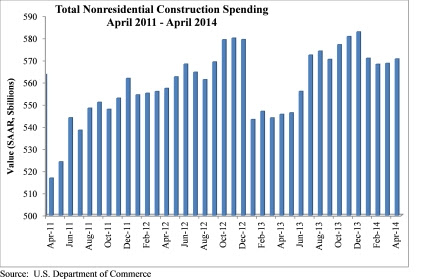Nonresidential construction spending inched up in April according to the June 2 release by the U.S. Census Bureau. This is the second consecutive month spending has increased following March’s upwardly revised spending report.
Nonresidential construction spending expanded by 0.4% on a monthly basis in April and has risen 3.9% on a year-over-year basis. Spending for the month totaled $570.6 billion on a seasonally adjusted, annualized basis.
“Unsurprisingly, nonresidential construction spending has improved with the weather,” said Associated Builders and Contractors Chief Economist Anirban Basu. “As a result of the unusually harsh winter weather, spending declines appeared large during the winter months and subsequent monthly gains have perhaps been a bit exaggerated as well. While the monthly numbers may be skewed, the year-over-year advance of 3.9% seems to realistically capture the rate of improvement in nonresidential construction spending.”
“The U.S. economy has recovered its momentum since the first quarter, suggesting that nonresidential construction’s steady recovery will remain in place,” said Basu. “Indeed, measures of business confidence have improved significantly and there are indications that capital spending is set to accelerate.”
Ten of 16 nonresidential construction subsectors posted increases in spending in April.
• Lodging construction spending is up 1.9% on a monthly basis and is up 16.9% on a year-over-year basis.
• Office-related construction spending grew by 1.7% in April and is up 20% from the same time one year ago.
• Construction spending in the transportation category expanded 3.4% on a monthly basis and has expanded 8% on an annual basis.
• Religious spending grew 1.8% for the month but is down 5.9% from the same time last year.
• Education-related construction spending gained 2.7% for the month and is up 2.9% on a year-over-year basis.
• Commercial construction spending rose 1.2% in April and is up 5.9% on a year-over-year basis.
• Sewage and waste disposal-related construction spending gained 4% for the month but has fallen 5.5% from the same time last year.
• Amusement and recreation-related construction spending expanded 4.4% on a monthly basis and is up 3.2% from the same time last year.
• Health care-related construction spending grew 0.9% for the month, but is down 6.2% on a year-over-year basis.
• Conservation and development-related construction spending expanded by 3.6% for the month and is up 19.7% on an annual basis.
Spending in six nonresidential construction subsectors declined in April.
• Spending in the water supply category fell 0.2% on the month and is down 12.8% from the same time last year.
• Manufacturing-related spending fell 1.1% on a monthly basis, but is up 6.7% on an annual basis.
• Highway and street-related construction spending fell 1.1% in April, but is up 4.8% compared to the same time last year.
• Communication construction spending was down 11.7% for the month but is up 21% from the same time one year ago.
• Public safety-related construction spending fell 0.9% on a monthly basis and has declined 12.4% on a year-over-year basis.
• Power construction spending dipped 1.2% for the month and was 1.6% lower than the same time one year prior.
Related Stories
| Aug 11, 2010
Florida mixed-use complex includes retail, residential
The $325 million Atlantic Plaza II lifestyle center will be built on 8.5 acres in Delray Beach, Fla. Designed by Vander Ploeg & Associates, Boca Raton, the complex will include six buildings ranging from three to five stories and have 182,000 sf of restaurant and retail space. An additional 106,000 sf of Class A office space and a residential component including 197 apartments, townhouses, ...
| Aug 11, 2010
Restoration gives new life to New Formalism icon
The $30 million upgrade, restoration, and expansion of the Mark Taper Forum in Los Angeles was completed by the team of Rios Clementi Hale Studios (architect), Harley Ellis Devereaux (executive architect/MEP), KPFF (structural engineer), and Taisei Construction (GC). Work on the Welton Becket-designed 1967 complex included an overhaul of the auditorium, lighting, and acoustics.
| Aug 11, 2010
Best AEC Firms to Work For
2006 FreemanWhite Hnedak Bobo Group McCarthy Building Companies, Inc. Shawmut Design and Construction Walter P Moore 2007 Anshen+Allen Arup Bovis Lend Lease Cannon Design Jones Lang LaSalle Perkins+Will SmithGroup SSOE, Inc. Timothy Haahs & Associates, Inc. 2008 Gilbane Building Co. HDR KJWW Engineering Consultants Lord, Aeck & Sargent Mark G.
| Aug 11, 2010
High-Performance Workplaces
Building Teams around the world are finding that the workplace is changing radically, leading owners and tenants to reinvent corporate office buildings to compete more effectively on a global scale. The good news is that this means more renovation and reconstruction work at a time when new construction has stalled to a dribble.
| Aug 11, 2010
Great Solutions: Business Management
22. Commercial Properties Repositioned for University USE Tocci Building Companies is finding success in repositioning commercial properties for university use, and it expects the trend to continue. The firm's Capital Cove project in Providence, R.I., for instance, was originally designed by Elkus Manfredi (with design continued by HDS Architects) to be a mixed-use complex with private, market-...
| Aug 11, 2010
Nurturing the Community
The best seat in the house at the new Seahawks Stadium in Seattle isn't on the 50-yard line. It's in the southeast corner, at the very top of the upper bowl. "From there you have a corner-to-corner view of the field and an inspiring grasp of the surrounding city," says Kelly Kerns, project leader with architect/engineer Ellerbe Becket, Kansas City, Mo.
| Aug 11, 2010
AIA Course: Historic Masonry — Restoration and Renovation
Historic restoration and preservation efforts are accelerating throughout the U.S., thanks in part to available tax credits, awards programs, and green building trends. While these projects entail many different building components and systems, façade restoration—as the public face of these older structures—is a key focus. Earn 1.0 AIA learning unit by taking this free course from Building Design+Construction.
| Aug 11, 2010
BIM adoption tops 80% among the nation's largest AEC firms, according to BD+C's Giants 300 survey
The nation's largest architecture, engineering, and construction companies are on the BIM bandwagon in a big way, according to Building Design+Construction's premier Top 50 BIM Adopters ranking, published as part of the 2009 Giants 300 survey. Of the 320 AEC firms that participated in Giants survey, 83% report having at least one BIM seat license in house, half have more than 30 seats, and near...
| Aug 11, 2010
World's tallest all-wood residential structure opens in London
At nine stories, the Stadthaus apartment complex in East London is the world’s tallest residential structure constructed entirely in timber and one of the tallest all-wood buildings on the planet. The tower’s structural system consists of cross-laminated timber (CLT) panels pieced together to form load-bearing walls and floors. Even the elevator and stair shafts are constructed of prefabricated CLT.
| Aug 11, 2010
Integrated Project Delivery builds a brave, new BIM world
Three-dimensional information, such as that provided by building information modeling, allows all members of the Building Team to visualize the many components of a project and how they work together. BIM and other 3D tools convey the idea and intent of the designer to the entire Building Team and lay the groundwork for integrated project delivery.









